Description
 The rock sandpiper is a plump, medium-sized shorebird 7-8 inches in length. It has a thin black bill with a yellow base that droops a little at the tip and short legs.
In the winter, it has a
slate-gray head, breast, and upperparts. The rock sandpiper is a plump, medium-sized shorebird 7-8 inches in length. It has a thin black bill with a yellow base that droops a little at the tip and short legs.
In the winter, it has a
slate-gray head, breast, and upperparts.
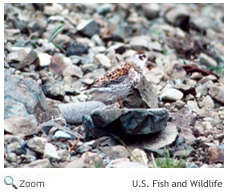 During the breeding season, it is a
rusty-red on its uppersides and has a white head and throat, a reddish-brown crown, a reddish-brown patch on the side of its face, and a black patch on its breast.
Males and females look alike, but females are slightly larger.
The rock sandpiper's coloring keeps it well camouflaged in its environment! During the breeding season, it is a
rusty-red on its uppersides and has a white head and throat, a reddish-brown crown, a reddish-brown patch on the side of its face, and a black patch on its breast.
Males and females look alike, but females are slightly larger.
The rock sandpiper's coloring keeps it well camouflaged in its environment!
Range 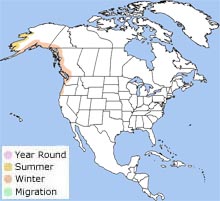 The rock sandpiper breeds in western Alaska. It winters
along the southern Alaska coast south to northern California. The rock sandpiper breeds in western Alaska. It winters
along the southern Alaska coast south to northern California.
| |
Habitat
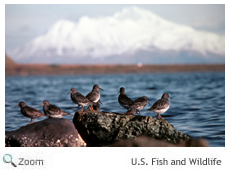 During breeding season, the rock sandpiper is found on mossy coastal tundra in Alaska. In winter, it is found on rocky shores. During breeding season, the rock sandpiper is found on mossy coastal tundra in Alaska. In winter, it is found on rocky shores.
Diet 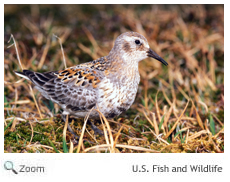 The rock sandpiper eats a wide variety of food, including
seeds, berries, moss, and algae. In the winter it eats
mollusks, crustaceans, and marine worms The rock sandpiper eats a wide variety of food, including
seeds, berries, moss, and algae. In the winter it eats
mollusks, crustaceans, and marine worms
Life Cycle
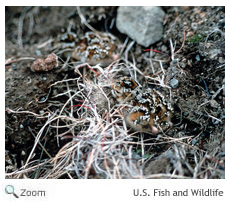 The female lays 2-4 eggs in a nest in a depression in the ground. Both parents incubate the eggs for about 20 days. The chicks are precocial and leave the nest and feed themselves shortly after hatching. Both parents care for the young. The chicks fledge when they are about 21 days old. The female lays 2-4 eggs in a nest in a depression in the ground. Both parents incubate the eggs for about 20 days. The chicks are precocial and leave the nest and feed themselves shortly after hatching. Both parents care for the young. The chicks fledge when they are about 21 days old. |